

|
|
 |
 |
 |
|
 |
BMW Garage | BMW Meets | Register | Today's Posts | Search |
 |

|
BMW 3-Series (E90 E92) Forum
>
Third’s the Charm: The Ultimate Driving Machine and a Belated Search for Fall Colors
|
 |
| 04-22-2017, 05:00 PM | #1 |
|
Lieutenant Colonel
 963
Rep 1,910
Posts |
Third’s the Charm: The Ultimate Driving Machine and a Belated Search for Fall Colors
 Featured on BIMMERPOST.com Well, it all started last Fall, when I’d planned to leave on a 3-day trip on October 22. It was to take me from the southernmost border of Pennsylvania to its northernmost and back again, on the theory that superb Fall Colors would lie somewhere in between. Then, the night before my departure, I clumsily fell at a volleyball game and broke my wrist. (Embarrassingly, I wasn’t even playing. I was just a spectator.)  The First Attempt Driving was difficult with my left arm in a cast, but 2 weeks later I decided to do a little bit of the trip anyway—just an afternoon’s worth. It was a beautiful day, and on my way to Pennsylvania from Maryland, I stopped at Terra Rubra—the birthplace of Francis Scott Key in 1779. Lo and behold, there were still some pretty decent Fall Colors there. Mr. Key went on to become a lawyer and wrote “The Star Spangled Banner” while witnessing the British attacking Fort McHenry in Baltimore during the War of 1812.   Starner’s Dam, outside of Taneytown, MD, was also colorful. I later learned that the bridge I stood on for this photo is haunted by a young Woman in White and her baby, who is often heard crying. I neither saw nor heard any sign of them, but there was a pronounced chill in the air—perhaps because it was November… 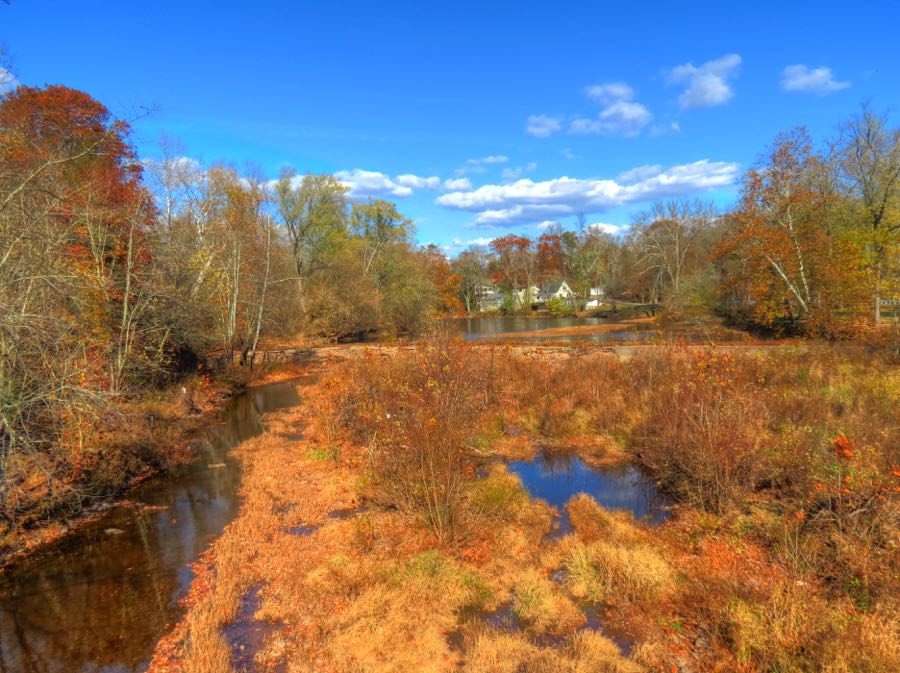 This sad edifice used to be the 1866 Mt. Zion Church in Harney, MD. Judging by the satellite dish hiding in the shrubs, it was used as a residence for a time. 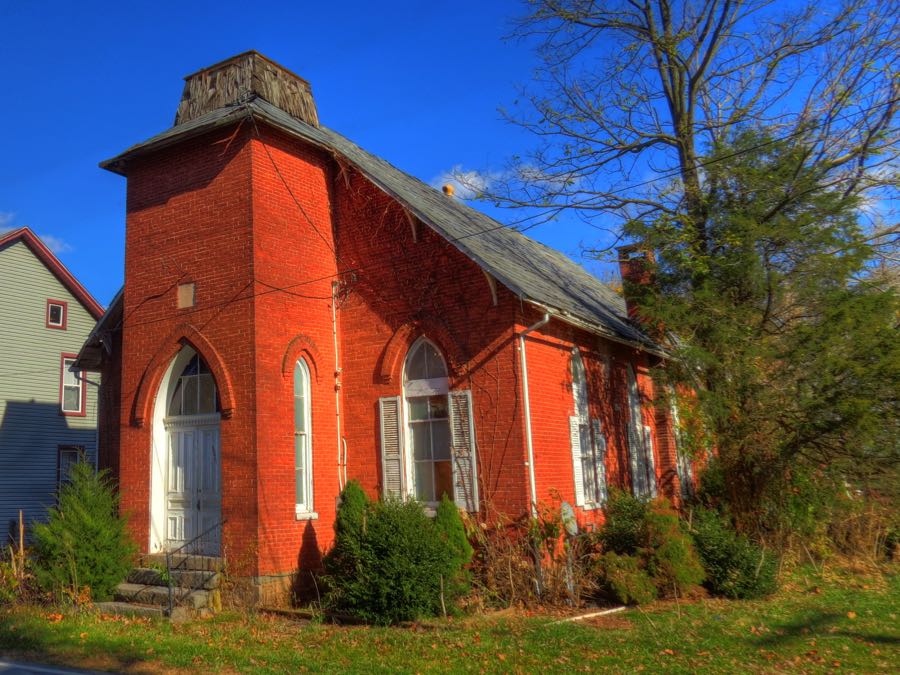 A few miles farther northward, I finally reached Pennsylvania—Gettysburg, to be specific. This is the stately Adams County Courthouse from 1858. As the Battle of Gettysburg ebbed and flowed, the clock tower was used as a lookout post by both Union and Confederate troops.  Under colonial governor William Penn, Pennsylvania welcomed immigrants of all religious faiths. Many Quakers settled here, starting in the 1730s. The Menallen Friends Meeting House was built in 1884 and continues to hold monthly services.  On the other side of Carlisle Road, I spotted a photographer’s dream: beautiful Fall Colors and a striking mansion. “Hill House” was built by Chester and Bertha Tyson in about 1900, and they raised their 12 children here.  Mount Holley Springs was a center for paper manufacturing in the 1800s (and still is today). Amanda S. Givens inherited the fortune her father made through paper mills, and she used it to build, furnish, and endow this library. It has served the town continuously since 1890. The other car parked out front, besides my handsome 335i, is a remarkably mal-proportioned Ford LTD coupe.  By the time I made it to Carlisle, PA, my wrist and hand were aching, and it was time to turn around. But first I found the old Cumberland County Prison (1854)…  …and, across the street, the monumental First Evangelical Lutheran Church (1900) and the 1811 home of Stephen Duncan and Margaretta Stiles Duncan. Sadly, Magaretta died suddenly just after the couple had moved in. Their house is believed to be the most expensive single-family home ever built in Carlisle. In 1863, as the Battle of Gettysburg was starting and General Robert E. Lee was wondering where in blazes his cavalry officer, J.E.B. Stuart was, Stuart’s forces were off shelling Carlisle. One of the cannonballs hit this house, made a neat, circular hole in a mirror on the wall, and smashed into a sofa on the far side of the room—moments after homeowner Susan Thorn had fled the room for safety in the basement. 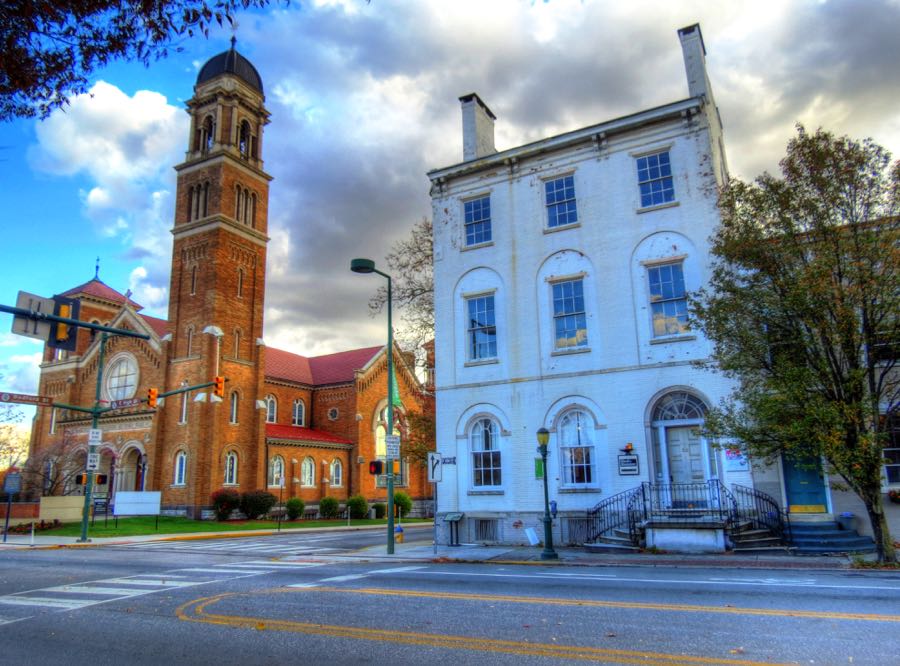 On my way back home, I had to stop at the Mt. Asbury Retreat Center and photograph this glorious tree. The faithful 355i had been running great, and these trips never fail to remind me just what a fantastic car it is—powerful, beautiful, able to corner on rails and stop on a dime, and even haul 4 people and their luggage around. (Okay, so long as they don’t bring a lot of luggage, this being the convertible hardtop E93 version…)  As I continued south on PA Highway 233, I suddenly spotted Ridge Road and remembered that it offered some great mountaintop views, perfect for spotting Fall Colors. Accordingly, I ventured west for a ways and then remembered that the best views were to the east. My up-’til-now clean BMW was getting a thorough coating of dust from the dirt road, but I was determined to find those Colors. Eventually I rediscovered Hammonds Rocks and was pleased to see that almost all of the graffiti had been removed. It’s an extraordinary spot—but there wasn’t a Fall Color in sight. 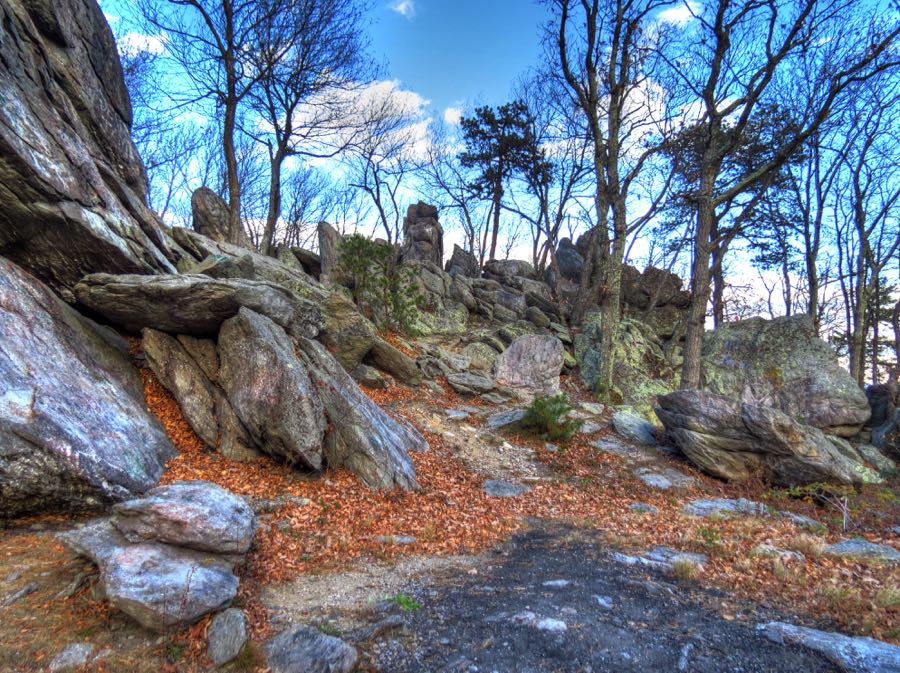 In case you’re wondering about the size of the rocks, here’s a picture of me (at 6’6”). It’s quite a jumble of boulders, and I’ll have to ask my geologist nephew Ben how it was formed.  Going down the side of the mountain, I managed to take this last, on-the-fly photo of Fall Colors. It was the magic hour, close to sunset, when the sun’s rays come in almost horizontally and light everything up. I’d had a lot of fun on this mini-version of my trip, but the rest would have to wait for another 4 months and 2 more tries.  Round Two: A Meteorological Knockout After waiting impatiently for my broken wrist to heal and to regain some strength in my hand, I was anxious to return to my PA Fall Colors trip. On March 3, despite forecasts of snow across much of the state, I ventured back to Carlisle and parts north. First on my list was a 1777 powder magazine, built by Hessian prisoners of war during the American Revolution. It was designed to hold 10,000 rifles and 200 tons of gunpowder for the Continental Army at the old Carlisle Barracks.  Sometime in the 1800s, the building was converted to a guardhouse. Today it’s a museum, complete with this mannequin in one of the cells. He looks suspiciously like my nephew Matt…  The Carlisle Barracks became the Carlisle Indian Industrial School in 1879 and served as such for the next 39 years. It was a massive social experiment, designed to address the rapidly diminishing Native American population through a “forced assimilation” into mainstream work and culture. The program was well-intentioned, and many Native Americans received an excellent education here and at other such schools patterned after Carlisle, but the experience was traumatic for a great many of the students. They had to entirely give up their native language, dress, and culture and adopt the ways of the white population. Students were punished if they behaved in any of their traditional ways.  Here’s a “then and now” comparison of the parade grounds. There is still a music pavilion, and the building on the far right is the same, but the balconied buildings in front are no longer standing. (Unless otherwise noted, historical images are courtesy of the Library of Congress or Wikipedia.)  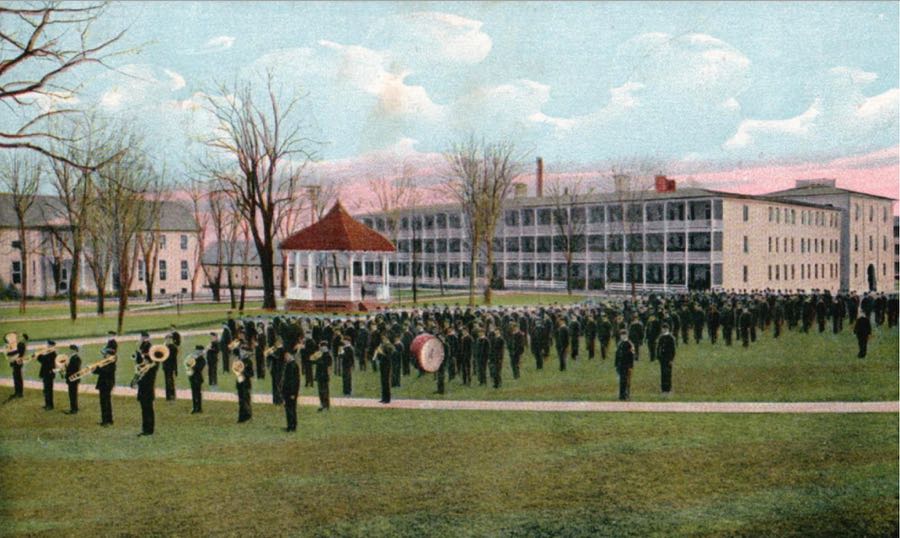 The low structure is the gymnasium, which is largely unchanged from the Industrial School days.  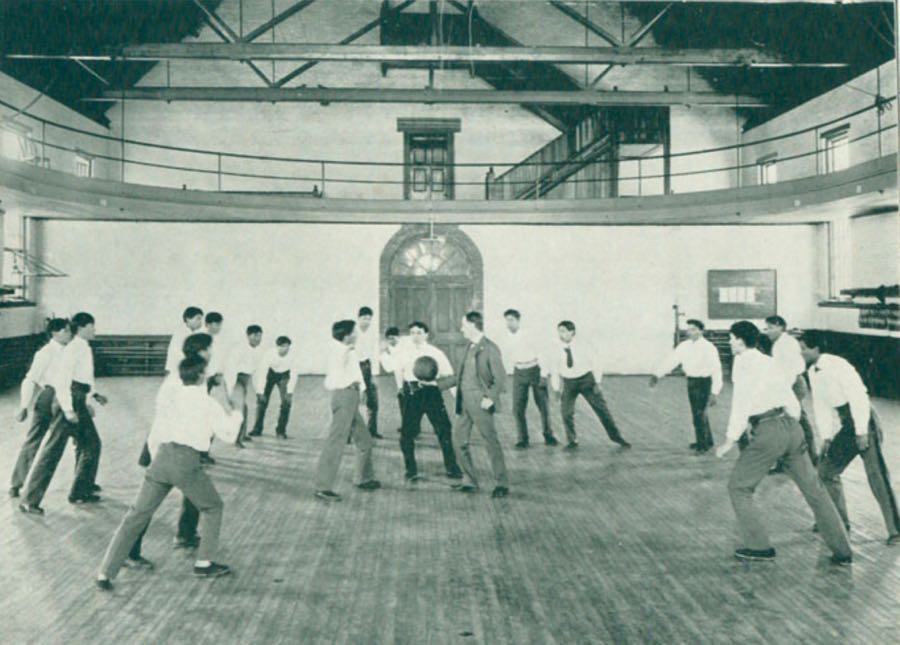 This was the residence of Captain Richard H. Pratt, who founded the school. He was the originator of the word “racism,” as part of his criticism of racial segregation. He is better known for his metaphorical motto “Kill the Indian, and save the man,” which summarized the goal of the assimilation effort. Capt. Pratt’s residence was previously the officers’ quarters for the Carlisle Barracks, before being burned by Confederates in 1863. It was rebuilt in its current form within a year.  Here’s another “before and after” photo, this time of “Tom” Torlino, a Navajo student at the Industrial School. It shows his appearance when he arrived in 1882 and then in 1885. Ultimately, the assimilation effort largely failed, with a majority of students returning home prior to graduation, and relatively few of the graduates participating in mainstream society. Out of roughly 10,000 students, historians estimate that only 150 to 800 graduated.  Sadly, a number of the students fell ill and died while attending the school, including Leah Road Troeller, a member of the Arapaho Nation who passed away in May 1888.  One of the school’s most famous students was Jim Thorpe. As he was walking to class one morning in 1907, he noticed the track and field team practicing. Jim walked over and, in his street clothes, cleared 5’9” in the high jump—better than any of the team members. The Industrial School’s coach—one Glen Scobey “Pop” Warner—spotted this feat and immediately drafted him onto the track and field team. And the baseball and football teams, too. Jim Thorpe went on to become one of the most talented athletes in U.S. history, winning gold medals in the 1912 Olympics and exceling in professional football, baseball, and basketball. For good measure, he also won the 1912 intercollegiate ballroom dancing competition!  Of course, Pop Warner also went on to become one of the most successful football coaches in U.S. history. This was his residence at the Carlisle school. 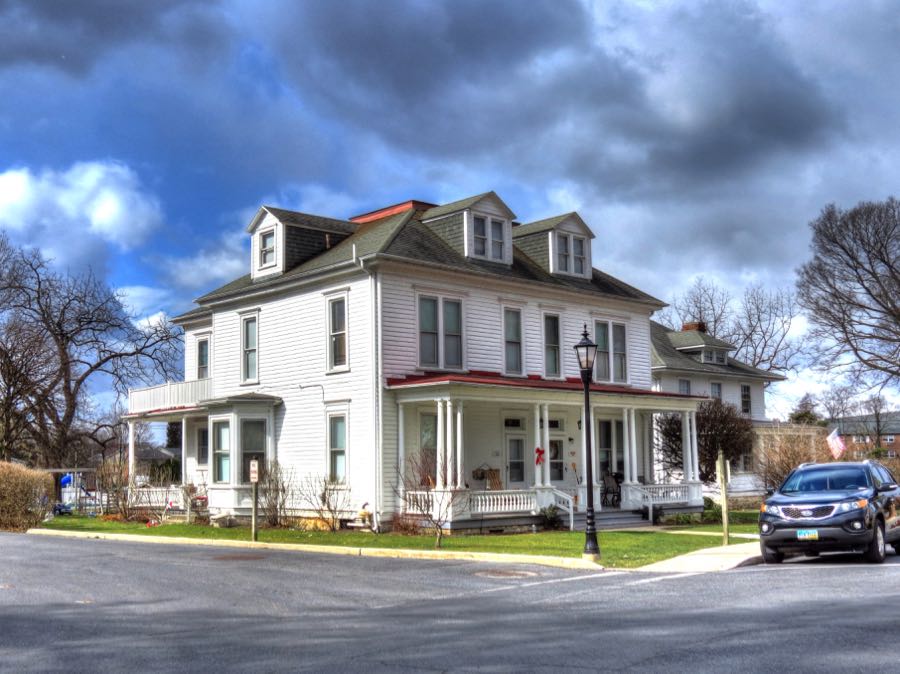  Today, the United States Army War College is located at the site of the Carlisle Barracks, offering a graduate program in strategic studies to senior military officers. Visitors are welcome, through the proper channels, and few places in the U.S. have such a long and varied history. As I left the War College grounds and continued north, the threatening clouds began to divest themselves of quantities of snow. Before long the ground was covered, and by the time I reached New Bloomfield the roads were covered, too. So far, the Bridgestone Blizzaks were handling the conditions just fine, but the storm was getting worse and worse. Moreover, I wasn’t supposed to be in New Bloomfield at all; the screen on my feckless Garmin Montana 600 had locked up a good 15 miles earlier, but I hadn’t noticed due to the conditions. No amount of tinkering would get it unlocked, and I now had no way to follow my intended route. With great reluctance, I instructed the 335i’s navigation system, which was working fine, to head home. It was probably just as well. Another 80 miles up Interstate 81, a sudden “whiteout” snow condition caused a 32-car pileup, with 1 fatality and 23 others hospitalized. Third is the Charm After waiting impatiently for another 3 weeks for clear weather conditions, I finally managed to complete my Fall Colors trip. Not that I expected to see any more Fall Colors, of course. Now it was a matter of principle, to undertake this south-to-north-to-south trip through Pennsylvania, come hell or high water! Armed with a brand-new Garmin Montana 610 GPS, the first step of this third effort was to motor the 113 miles to the Red Covered Bridge, outside of Liverpool, PA. It’s no longer in use, but—like many classic cars—it’s nice to see one in original condition rather than over-restored.  Pennsylvania is famous for its covered bridges, and they’re everywhere. This is the Aline Bridge, which, like the Red, was built in the late 1880s. 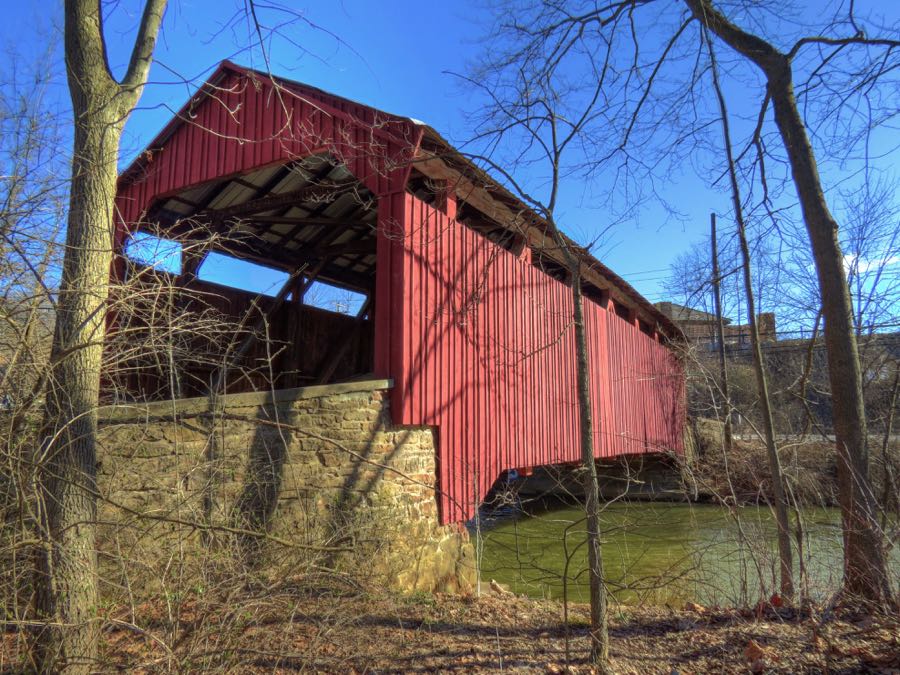 Continuing up Highway 104, I ran across Bob’s Cruiser Café. It’s a popular old-timey spot for hot rodders and bikers (and the occasional historical tourist). 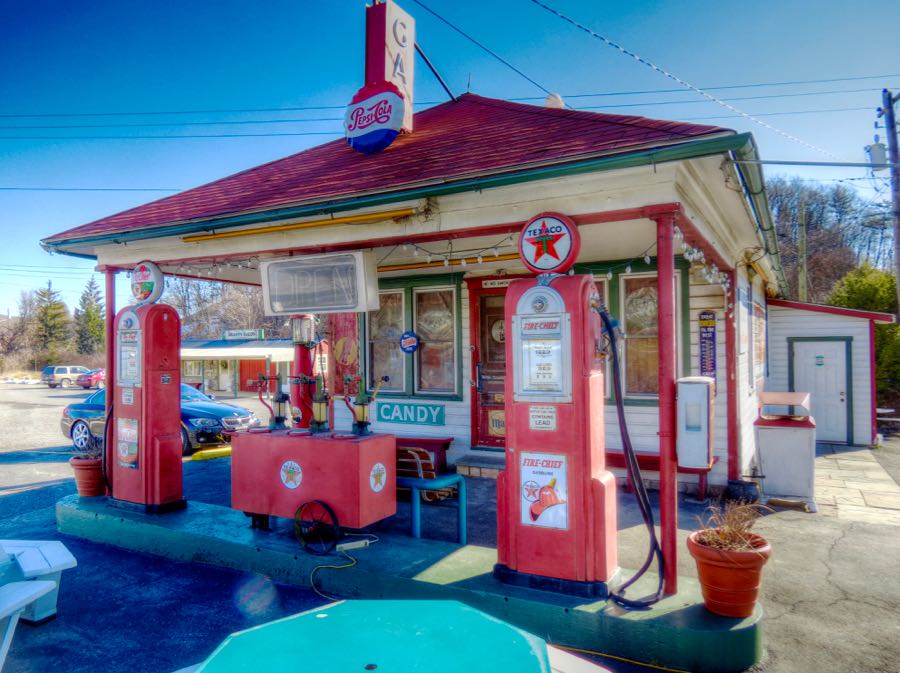 Middleburg, PA was originally called Swinefordstettle by Pennsylvania Dutch settlers. The former Snyder County Prison now serves as the town’s police department. As for county prisoners, they’re now in a facility outside of town, and their Crochet Program produces a blanket for every baby born at the hospital—through the volunteer efforts of both female and male inmates.  Continuing ever northward and passing through Miflinburg, I found the Hassenplug Covered Bridge and had the pleasure of hearing the 335i’s exhaust burble resonating off the walls as I drove across. It was built in 1825 across Buffalo Creek, making it the oldest in Pennsylvania and second-oldest in the country. I saw no sign of buffalo, however.  Winter State Park lived up to its name, with its frozen Halfway Lake and lots of snow. Because the lake is fed by springs, the water temperature is 50° year round. The dam was the first ever built by the Civilian Conservation Corps, a part of President Franklin Roosevelt’s New Deal in 1933.  By now, the poor 335i had acquired a layer of cinders and road salt. But it was great fun to take advantage of its prodigious acceleration and cornering abilities as I roared from site to site.  My route was based on a RoadRunner magazine tour, and it emphasized twists, turns, elevation changes, mountain passes—and beautiful views around every corner.  This rural miller’s house and nearby covered bridge in Logan Mills were typical sights in central Pennsylvania. I suspect that Logan Township is named for our old friend Tal·ga·yee·ta, better known as Chief Logan (see Crossing Mountains, Covered Bridges, and Cornfields by BMW and A Tale of Vengeance). 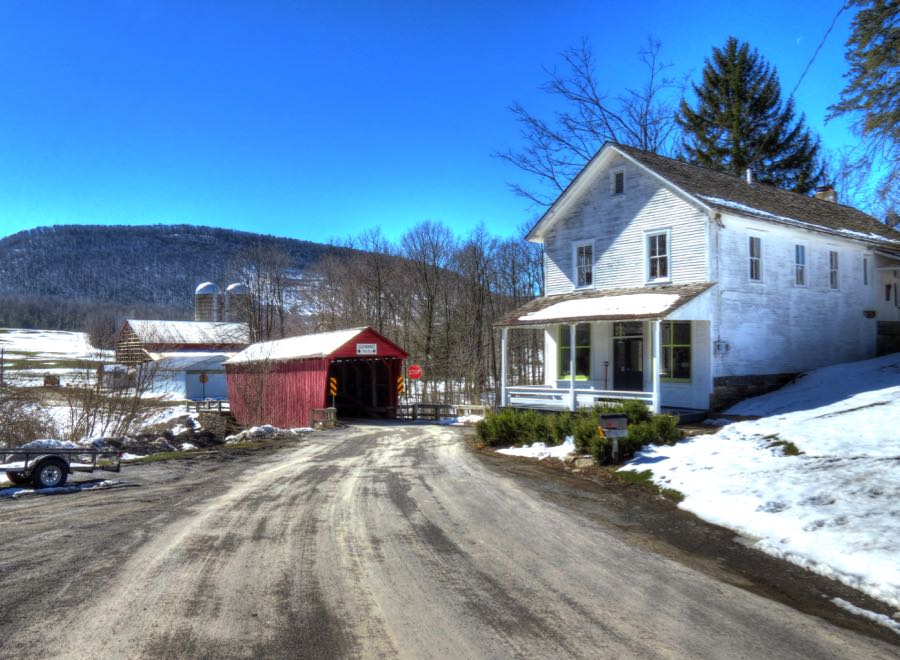 Given the low temperatures and cold wind blowing, I was surprised not to see any smoke from the chimney of this farmhouse. Perhaps they gave up and moved to Florida?  I’d meandered here in search of the township’s gristmill, which I found across the road from the farmhouse. It was built in 1840 and remains in remarkably good condition, complete with all of its handmade wooden operating equipment. Several museums have tried to buy this equipment, but the owners prefer to keep it here with the mill.  Did I mention all the snow I encountered? A major storm had swept through central PA the week before, dumping as much as 24 inches, but most of the roads had been cleared. 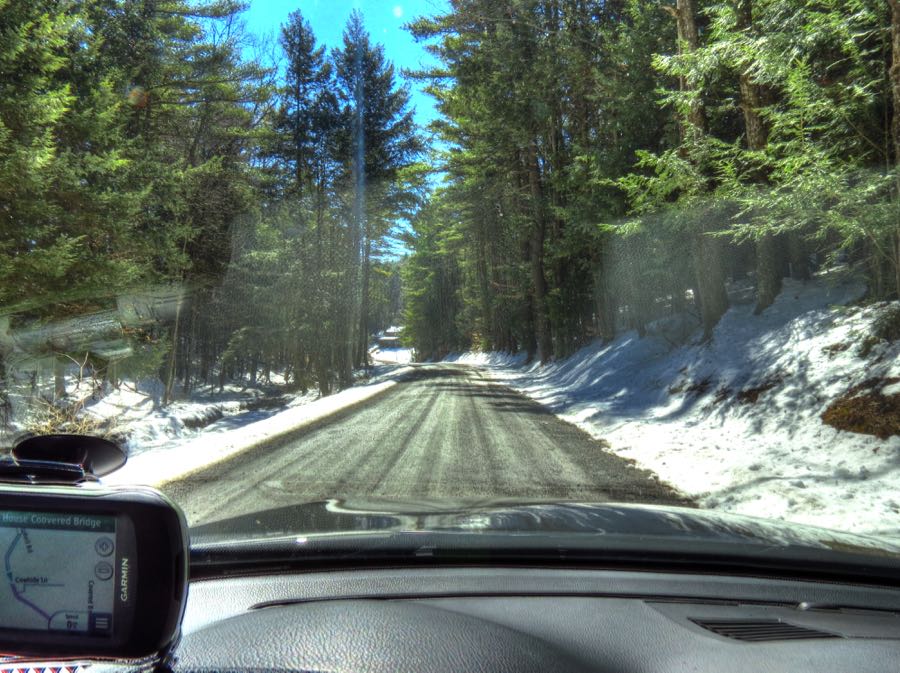 Not all, however, and getting to Larry’s Creek required a quarter-mile trek on foot through the snow. I could have done it in an X3, I’m sure, but the MSport 335i just doesn’t have the ground clearance.  I’d come in search of yet another historic bridge, of course, namely the Cogan House Covered Bridge, which features unusual open sides that revealed the inner Burr Arch trusses. It was built in 1877, and on June 1, 1889, it was the only bridge in Lycoming County to survive a massive flood. (The same rainstorm caused the Johnstown Flood, 150 miles southwest of here.) Although the bridge looked in good order, the 2009 National Bridge Inventory summarized its condition as “basically intolerable.”  By now I was within 25 miles of Pennsylvania’s northern border with New York. The surroundings had become increasingly rural, and it was rare to see another car, person, or other life form of any sort. Thus, it was a bit of a relief when I reached the old coal-mining town of Antrim with its striking Trinity Church. According to a local history, the village was named Antrim in 1868 “in honor of the County Antrim, Ireland, the native land of the Magees.” The cornerstone on the Trinity Church is dated 1880. (Interior photograph courtesy of A.D. Wheeler, the “Explorographer,” whose outstanding work is well worth viewing.)   In this historical photo of Antrim (courtesy of The History Center on Main Street), the Trinity Church is visible on the left. As best I can tell, the church is now privately owned and no longer holds services.  I’d been through Wellsboro, PA back in 2007 on a motorcycle trip with my college roommate and best friend Buzz (see The Grand Canyon of Pennsylvania). We somehow missed the Wellsboro Diner on that visit, which was a mistake since it turns out the diner has excellent food and a friendly staff. Be sure to try the egg custard pie when you visit!   I found interesting sights both new and old in Wellsboro, including this quaint home…  …this statue of Wynken, Blynken, and Nod in the town park (from the 1889 Dutch Lullaby, “Wynken, Blynken, and Nod one night, sailed off in a wooden shoe…”)…  …and a downtown area that still features most of the same buildings along historic Route 6 as this old photo. They’ve paved the wide street in the interim, and the 3-story building in the background seems to have disappeared somewhere along the way. (Historical photo courtesy of ExplorePAhistory.com.)   My next destination involved driving to the top of Middle Ridge. The first several miles were on a heavily rutted, muddy dirt road. The Blizzaks provided adequate forward traction, although the car slewed wildly as it followed the ruts. At a crossroads, I could see that the last half mile or so of the climb would be on a very steep, snow-covered path. Discretion being the better part of valor, I opted instead for a more gradual alternative route on paved roads and eventually reached the Middle Ridge Church. It appears to be made of brick, but it’s actually painted hemlock boards.  The church was worth the lengthy detour, and rather than slithering down the muddy road I found a different way back to my route. It involved a steep descent on a different muddy dirt road! Oh well…  Most state parks have a lake, forests, numerous trails, and maybe a waterfall or two. Cherry Springs State Park has none of these; instead, it has wide open spaces and these weird little igloo-shaped huts. At an elevation of 2,300 feet and away from most civilization, the park turns out to be a perfect “dark sky” site for astronomy. The domes in the photo, incidentally, are used to keep wind from affecting the telescopes. The park is considered the best place for stargazing in the eastern half of the U.S. For a taste, check out Brian Garrett’s Cherry Springs Time Lapse video. (Park sky photo below courtesy of Audrey Buck’s blog “The Lonely Doe.”) 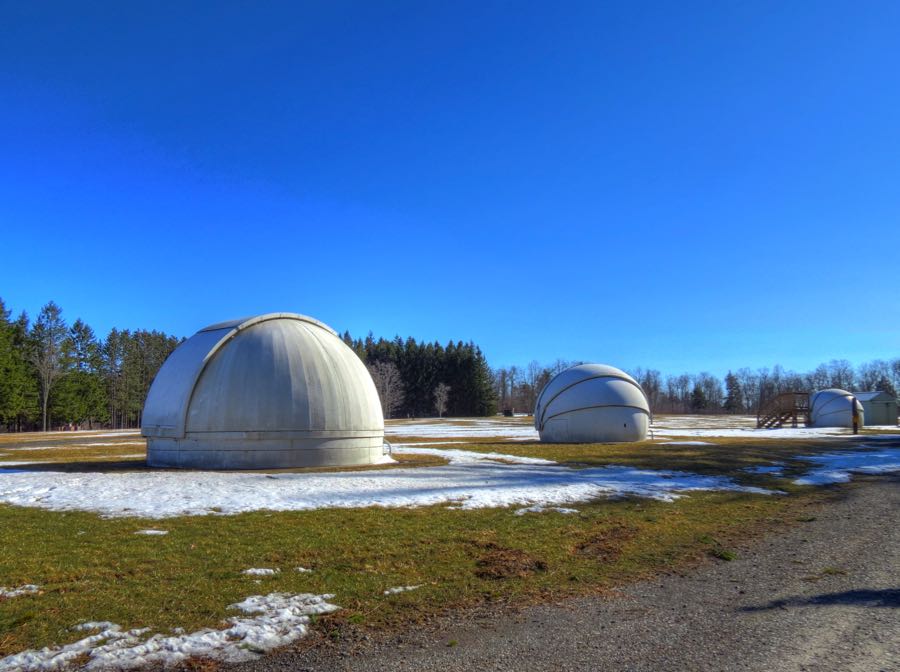  I’m told that, with clear skies, it’s possible to see 10,000 stars here with the naked eye. I looked but didn’t see any. The ranger suggested that I try waiting for nightfall. I contented myself with this view of Green Hollow, 600 feet below. 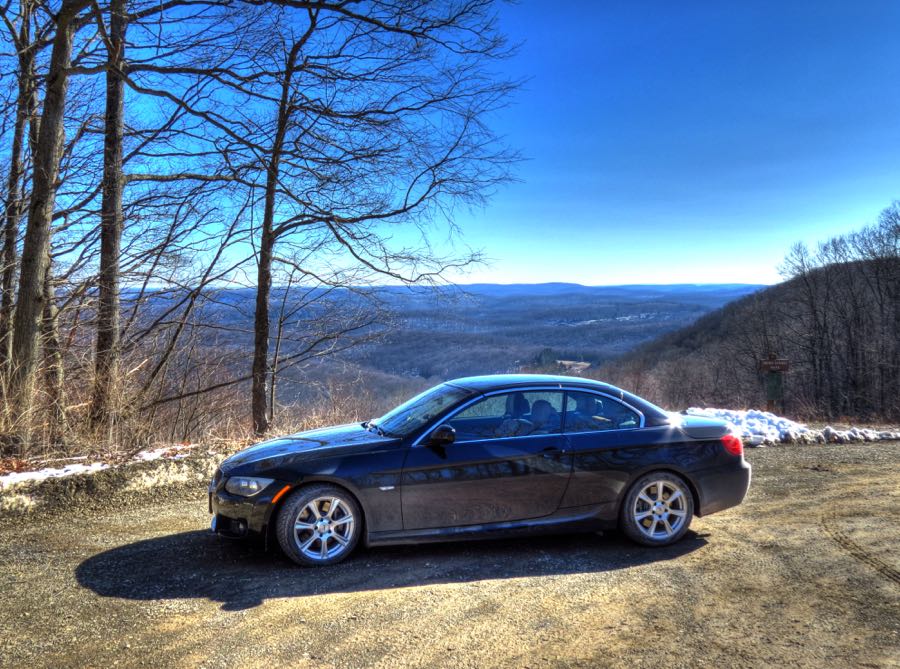 Fifteen miles farther on, I reached my destination for the first night—the welcoming Millstream Inn outside of Coudersport, PA. Best of all, they directed me to the nearby Millstream Car Wash, where I happily used $8.00 worth of quarters washing the long-suffering BMW, both top and bottom. A leisurely dinner at a nearby steak restaurant, and I was ready for bed. Anybody Got a Light? The next morning, I was surprised to find a crusty layer of frost on the noble BMW. It had been cold the day before, but now the car’s outside temperature gauge read only 9°! (That’s –13° Celsius, for my European friends. In other words, dang cold by any reasonable standard.)   After breakfast, my first stop was the Coudersport Consistory on the banks of the Allegheny River. Here, lawyer Isaac Benson built a magnificent mansion in 1887. The Masonic Lodge of Perfection acquired the property in 1912 and added to it considerably in subsequent years, including a prominent cathedral. I’d never heard of a “consistory,” so I’ll quote from www.masonicdictionary.com: “The meetings of members of the Thirty-second Degree, or Sublime Princes of the Royal Secret in the Ancient and Accepted Scottish Rite, are called Consistories.” It’s good to learn something new each day… Their website notes that there are more members of the Coudersport Consistory than there are residents of the town of Coudersport.  The previous night, as I’d driven to the car wash, I’d noticed what looked like a marvelous old abandoned mansion, smack in the middle of Coudersport. I returned in the morning, and there it was.  My initial impression had been that it was tall and very narrow. A more careful look revealed just how massive this building is. Thanks to Buzz’s sleuthing efforts, I now know that this was “Old Hickory,” a mansion built by Francis Knox in 1880. Unlike most of Coudersport, Old Hickory survived the horrific fire that swept through the city a few weeks later. The home became an inn in 1928, named for former President Andrew Jackson. Old Hickory has sat vacant from about 1990 through the present, but it was purchased last year with the intention to renovate the property and make it a bed and breakfast. I fervently hope the new owners succeed. (Drawing courtesy of EndeavorNews.com.)   As I continued to head north and west, I occasionally took various side roads to see if they offered anything interesting. Sometimes it was a little hard to remember just where the real roads were.  Despite such detours, by 9:00 AM I’d reached the northern border of Pennsylvania, near Shinglehouse. On the other side of Oswayo Creek was Ceres, New York, which looked even more deserted than Shinglehouse. With little to see here, I moved on to Eldred, PA, where I found this World War II museum. Note: that’s an actual M551 Sheridan army tank protruding through the wall of the museum! (We’ll overlook the fact that the Sheridan wasn’t introduced until the Vietnam era.)  This part of Pennsylvania is not heavily populated, although Derrick City manages to have at least 2 or 3 motels—including the Model T Inn. Like all car enthusiasts, I would love to have a lift in my garage. This, however, isn’t exactly what I have in mind…  The Crook Farm is located north of Bradford, PA, and was the first producer of oil from the Bradford Oil Field. It’s easy to forget that petroleum wasn’t used for energy in the U.S. until it was discovered in Pennsylvania in 1859. For the next 30 years, Pennsylvania was the largest producer of oil in the country. Today, the Crook Farm is home to the Bradford Landmark Society. Some of the buildings are original to the farm, while others have been moved here.  The schoolhouse on the left was built in 1850, while the bank is a new “retro” building, used for Society meetings and square dances.  Although the farm was not open for tours when I visited, nobody seemed to mind my wandering around and peeking through windows. The farmhouse was built sometime after 1847 and is the oldest building in this part of Pennsylvania. The debts incurred in its construction were eventually paid off only as a result of profits from the oil well. 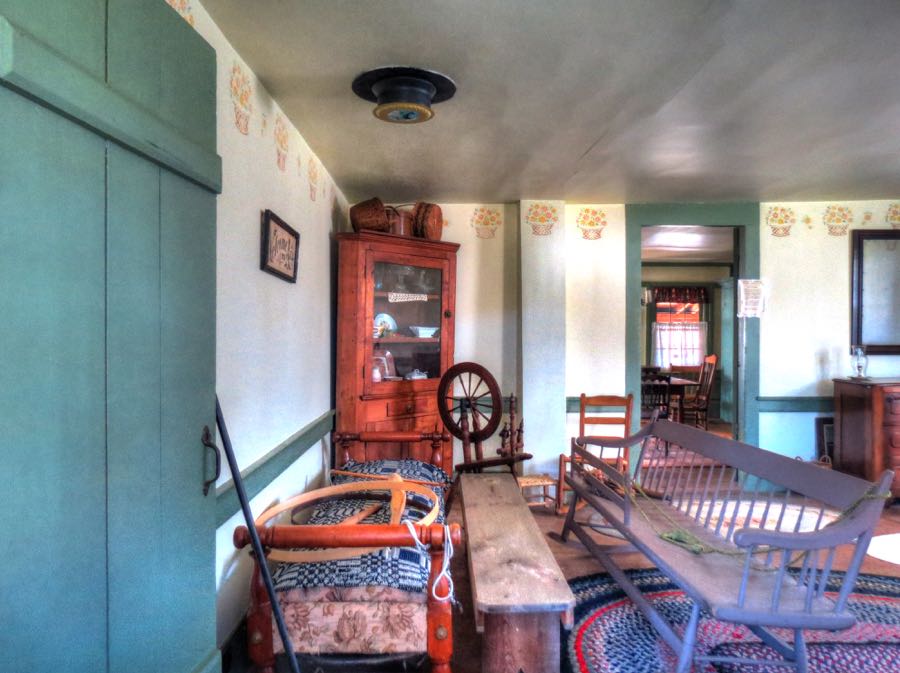 Bradford was settled in 1823 but didn’t take off as a city until the oil boom. Kendall Racing Oils—the premier oils for such use for many years—were produced here, and the local Taylor Brothers Aircraft Corporation pioneered as user-friendly airplane in the 1930s called the Taylor Cub. After the factory was destroyed by fire, William Piper bought the company, relocated to Lock Haven, and the renamed Piper Cub went on to start an entire new branch of aviation. This is the Old City Hall in Bradford, complete with its “Victorian eclecticism” architectural style and a Seth Thomas clock in the tower with four faces.  There are many stately homes in Bradford, but the “Congress Castle” is my favorite. It’s located on Congress Street and has a castle-like crenelated tower.  A key employer in Bradford is the Zippo Lighter Company, which now also owns the Case Cutlery Company. Best of all, they have an excellent museum on the factory grounds.  This American flag is made up of 3,393 individual Zippo lighters. All of them were interesting in one way or another…   This Harley-Davidson Street Bob is a tribute to George Blaisdell, the founder and inventor of the Zippo Windproof Lighter. The first Zippo lighter was manufactured in 1933, and all of their lighters ever since have carried an unconditional lifetime guarantee. I’ve never smoked and have no particular need for a lighter, but I couldn’t help buying a Gettysburg 150th anniversary edition in the gift shop, just because they are so cool.  Where Did Everyone Go? Outside of Bradford, and for the next 60 miles, I motored through the Allegheny National Forest—and did not see even one other car on the roads. I was beginning to wonder if a national emergency had been declared and I had missed the call to evacuate the area. But the roads were in good condition, the temperature was climbing, and it was a great opportunity to provide some exercise for the willing 335i. In the distance there was a mammoth lake, which turned out to be the Allegheny Reservoir. After a 1936 flood that devastated Pittsburgh, Congress and the Army Corps of Engineers leapt into action to create a series of dams for flood control and hydroelectric power. Just, uh, 29 years later, the Kinzua Dam was completed on the Allegheny River, creating one of the largest reservoirs east of the Mississippi. As I approached the lake, I couldn’t help noticing the low level of the water. Here, Sugar Run comes in from the left and meets the North Branch Sugar Run on the right, with both emptying into the lake in the distance. I estimated that, normally, this spot would be at least 5 to 10 feet under water. 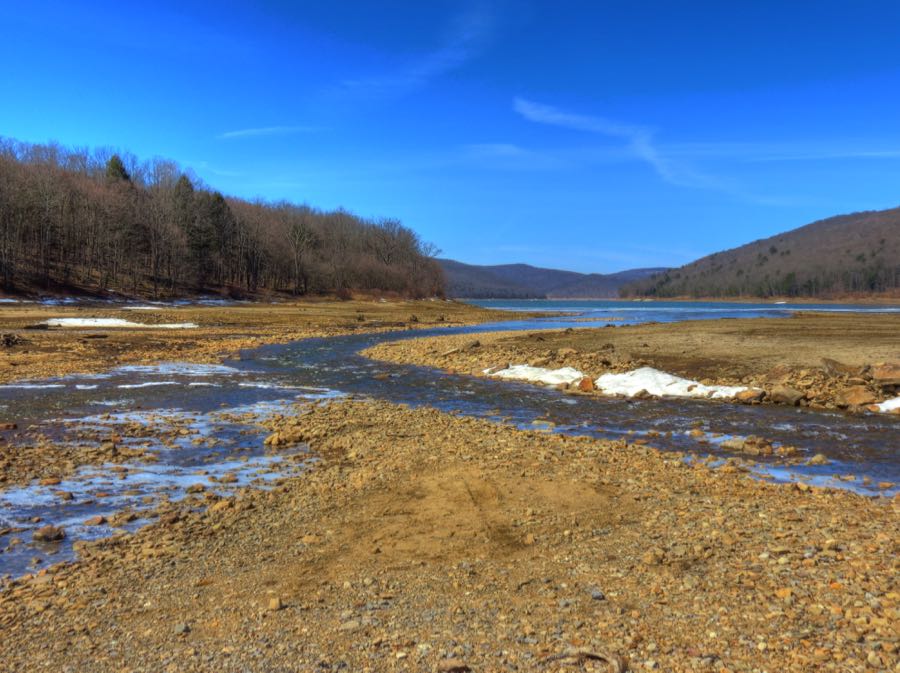 The 335i was still fairly clean, despite some snowmelt and dirt roads. I suppose I’m biased, but the E92 and E93 BMWs have always struck me as among the most handsome cars the company has ever built.  Near the outskirts of the Allegheny National Forest, I happened across a very large boulder with this little moss and pine garden growing on top of it. I have no idea how any plants can sustain themselves on top of a rock, but there they were.  Those Who Live by the River… In 1846, Michael Decker emigrated to the U.S., joining thousands of other Bavarian Catholics in the town of St. Marys, PA. He became a farmer but suffered serious injuries when he fell from a tree. Following the customs of his homeland, he vowed that, should he recover, he would build a chapel in honor of God. He did get well, and Decker’s Chapel (1858) was the result. The tiny, 12 x 18 foot building has been in use for nearly 150 years. In theory, the chapel can accommodate as many as 30 worshippers—if they don’t mind kneeling.  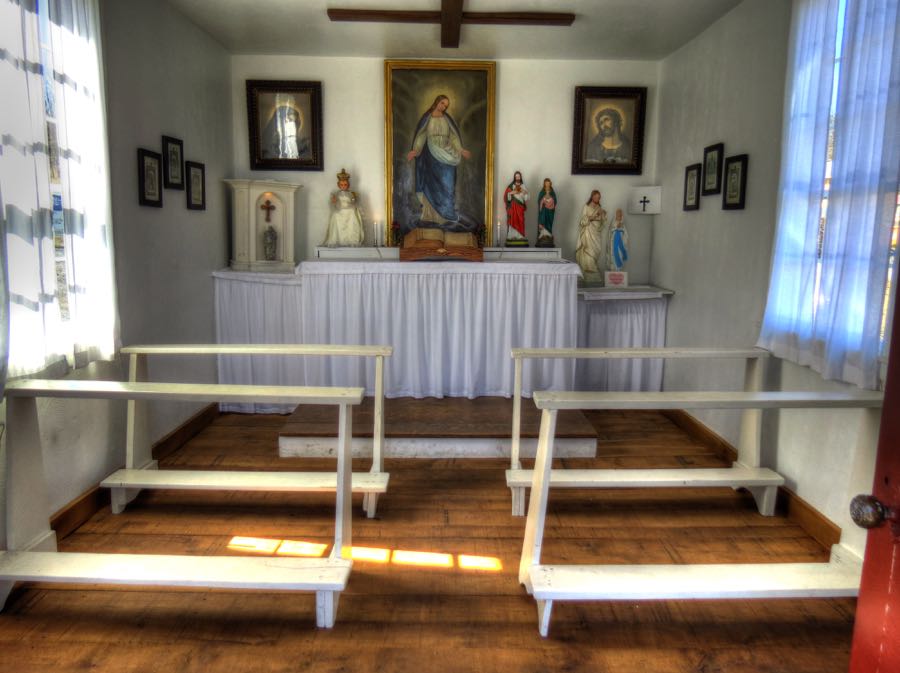 Did I mention the great roads comprising the RoadRunner route? This section of Route 120, south of Emporium, was typical. 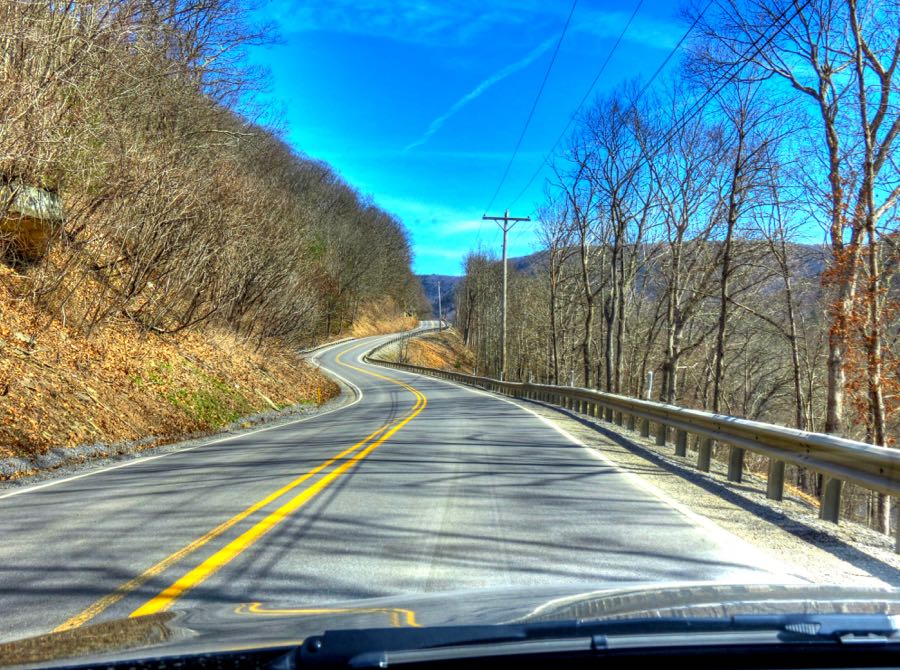 By early afternoon, the temperature had risen to 40°, and it was time to lower the hardtop. Still, sights such as this frozen mini-waterfall were pretty common.  This placid spot alongside the Driftwood Branch of Sinnemahoning Creek just begged to be photographed. 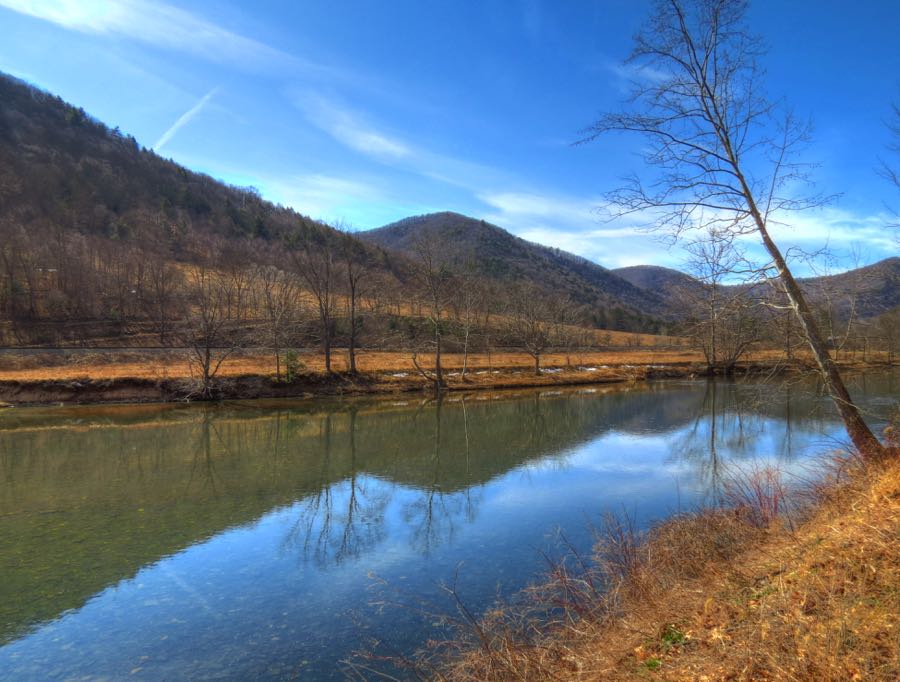 As did the 335i, although, yet again, it had managed to place itself directly between the sun and my camera. In case you were wondering, this branch of Sinnemahoning Creek is named for the town of Driftwood, PA (more properly called a “borough” in Pennsylvania’s arcane system of counties, townships, boroughs, and cities). Driftwood was once a prosperous lumber boomtown, but these days its population has dwindled to only about 60 people.  Another (and rather larger) borough is Renovo, on the banks of the West Branch Allegheny River. It suffered major floods in 1847, 1889, 1894, 1936, 1942, 1945, 1946, 1964, and 1996, but on this day the town was high and dry. This is St. Joseph’s Catholic Church, built in 1892. I always admire such beautiful buildings—but sometimes there is a darker side to them. I later learned that 7 priests at St. Joseph’s abused dozens of children over a period spanning several decades. Although the evidence was overwhelming, Attorney General Kathleen Kane was unable to bring charges last year due to the statute of limitations. A few months later, as it happens, AG Kane herself was convicted of perjury, conspiracy, and obstruction of justice, relating to other matters.  Highway 120 runs alongside the West Branch Allegheny all the way to Lock Haven, which was my destination for the night. I arrived by late afternoon and admired the view of the river and the J Street Bridge from Canal Park. An 800-foot-long covered bridge crossed the river here in 1852, but it burned in 1919. Local legend says that it was set afire by a woman who wanted to prevent her philandering husband from coming home. 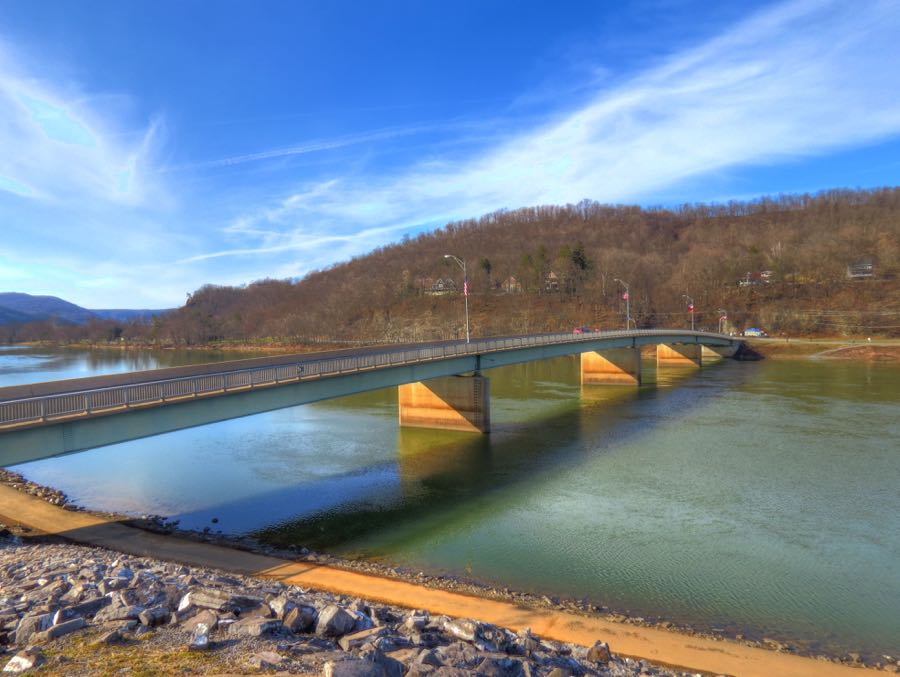  I’d been to Lock Haven at least twice before, each time admiring the 1867 Clinton County Courthouse on Water Street, with its Byzantine appearance. Considering that Lock Haven’s first courthouse was set in a local tavern, they deserved something a bit fancier.  Dinner that night was at the excellent Main Street Bar & Grill. If I had looked westward from the restaurant on St. Patrick’s Day in 1936, this is what I would have seen. Lock Haven, too, has suffered from many floods over the years. (Photo courtesy of the Pennsylvania State Archives.) 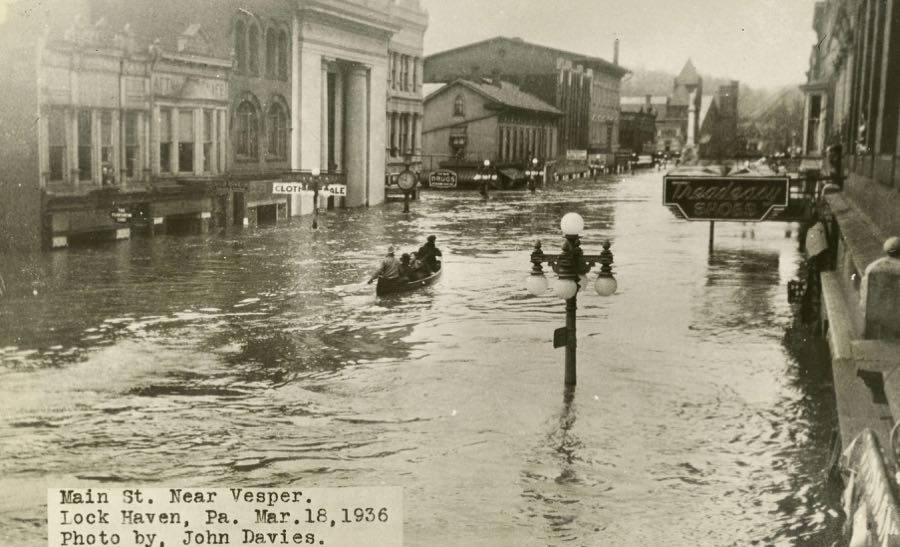 The Iron Age The next morning was rainy and might even have been considered dreary—except that nothing is dreary when boundless adventure awaits, in the form of historical tourism powered by BMW horsepower. This old house in Blanchard looks restorable, if tackled before too long.  Nearby, the early morning sun was trying its best to break through the cloud cover.  Christian Bechdel II was 5 years old when his family moved here in 1790. By 1831, he was prosperous enough to build this elegant brick house, complete with a rare Palladian window on the second story, overlooking the entrance. Christian was both a farmer and a distiller of whiskey, which probably helped with his prosperity. Construction of the Foster Joseph Sayers dam in 1971 destroyed most of the historic properties in this area, with the Bechdel House being a rare exception. It has remained in the family ever since. 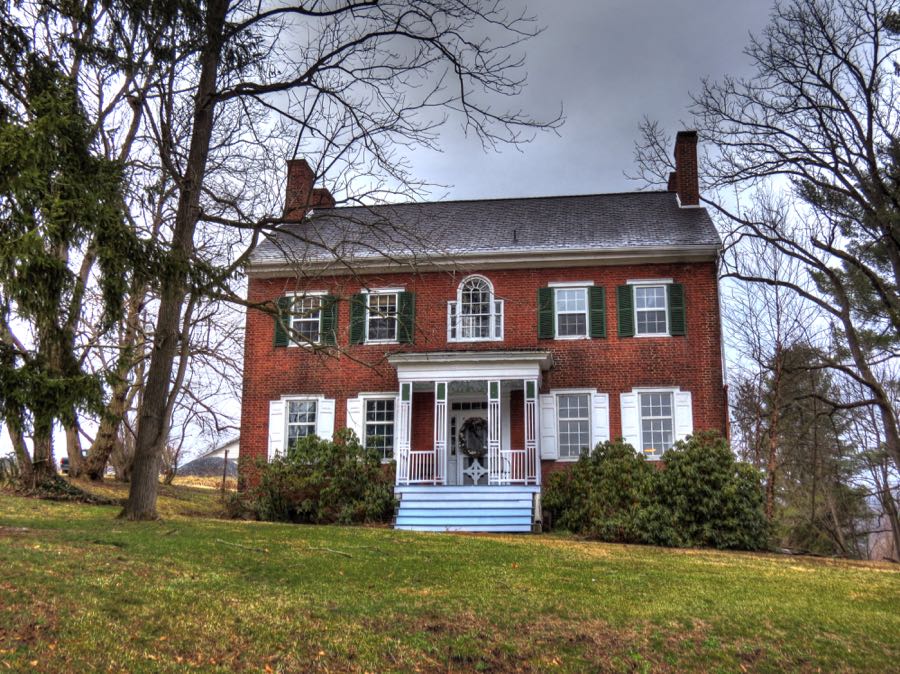 Sayers Reservoir is quite a sight, even with low water levels.  The tiny borough of Howard is nestled between shores of the reservoir, having narrowly escaped the efforts of the Corps of Engineers. Foster Joseph Sayers is buried here; he fought heroically in France during World War II and was posthumously awarded the Medal of Honor. This is the Lakeside Mennonite Church.  In 1793, Irishman Roland Curtin was a student in Paris and minding his own business during the French Revolution—until the Reign of Terror began. He escaped the city and emigrated to the U.S., settling in Bellefonte, PA. By 1810, he started the Eagle Ironworks at what is now called the Curtin Village, and he built this mansion for his family in 1830.  The iron furnace was successful, and an entire workers’ village grew here, with free housing for employees and (for once) a seemingly fair company store. The ironworks continued to operate until 1921 and was the last “cold blast” furnace in use in the country. Today the property is owned by the Pennsylvania Historical and Museum Commission, and guided tours are offered from June through October. The water wheel in this photo provided power for operating the bellows, needed to heat the flames of the furnace.  The furnace stack has survived and can be seen underneath the wooden blast house. In the foreground is the water trough that fed the water wheel. Several of the workers’ houses can also be seen elsewhere on the property. 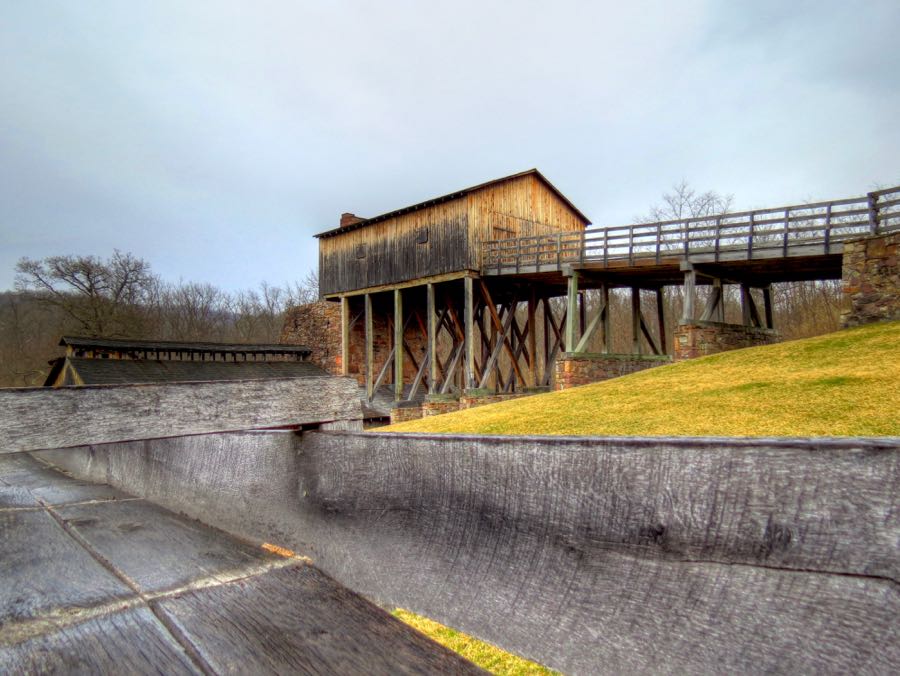 Three of Roland’s sons went into the family business, but the fourth—Andrew Gregg Curtin—went into politics. He became a close friend of Abraham Lincoln and was elected Governor of Pennsylvania in 1860. Following the Battle of Gettysburg, Gov. Curtin led the establishment of the new national cemetery—and invited President Lincoln to attend the dedication, where he delivered the Gettysburg Address. The Case of the Missing Manse Moving on, I found myself in Milesburg, which was named for General Samuel Miles, who served valiantly in the Battle of Long Island during the American Revolution. His holding action against the British enabled George Washington and the bulk of the Continental Army to escape capture. Equally interesting, given recent U.S. election issues, Gen. Miles became the first-ever “faithless elector,” having pledged to vote for John Adams in the Electoral College but instead voting for Adams’ rival, Thomas Jefferson. Milesburg had a few interesting old places, such as the 1860 Iddings-Baldridge House…  …and the stately Milesburg Baptist Church from 1869.  What turned out to be most intriguing, however, was this back entrance to the Presbyterian Church manse. Or what used to be the manse—there was nothing on the other side of this door! A local member of the church told me that the minister had his own house, the manse was expensive to keep up, and they’re in the process of tearing it down. Interesting; as shown in the Google Maps view, it was quite a substantial dwelling.    Other stately houses in Milesburg are doing just fine, thank you, such as this beauty. But I was on my way to Bellefonte, PA, home of more mansions per square block than just about anywhere.  The Most Wonderful Borough in Pennsylvania? Bellefonte reminded me of West Virginia, in that it is vertical in the extreme. I bumped into a friendly, historically minded postman here, and he pointed me in the direction of several local sights. He walks 11 miles a day up and down these hills!  Linn Street was practically wall-to-wall mansions. It was impossible to take them all in.  My favorite was the Major William F. Reynolds mansion, which was built in 1885 in a breathtaking mix of Queen Anne, Gothic, and Italianate styles, using unusual “blue brownstone.” It has 30 rooms, including a “snuggery” (to which gentlemen would retire after dinner, to smoke cigars). The best news of all? It’s now the Reynolds Mansion Bed & Breakfast, which will definitely prompt a return visit to Bellefonte. 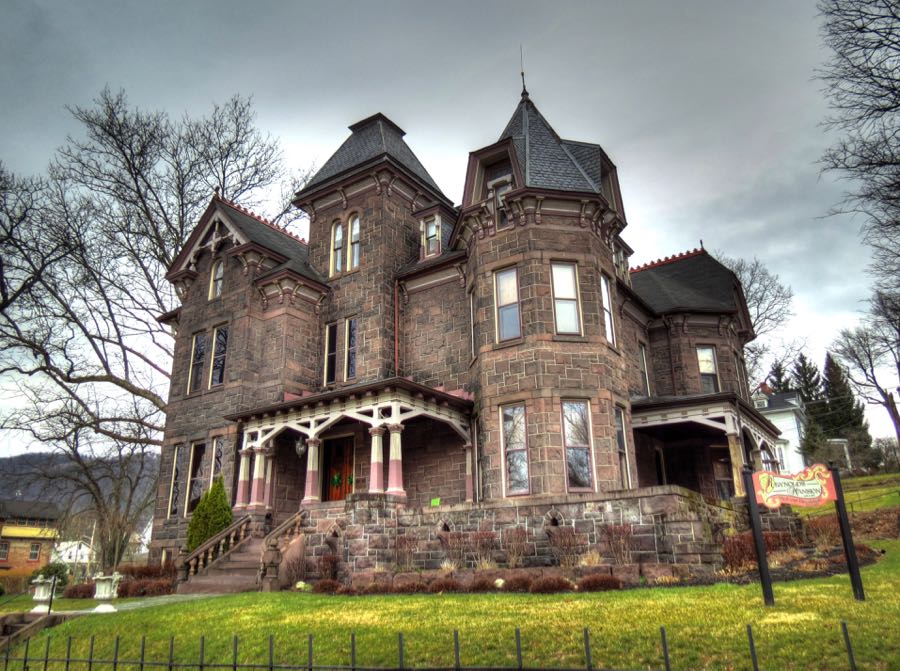 I mean, these beautiful homes were everywhere. The stunning display of mansions reflected Bellefonte’s prosperity from its ironworks, which were especially important to the Union cause throughout the Civil War.  There were many other, more modest homes as well. This one is fairly nondescript—but it was the childhood home of John Montgomery “Monte” Ward (1860-1925), who in 1880 pitched the second-ever “perfect game” in professional baseball (“27 up and 27 down”). He also started the first players’ union, and some say that he was the first to throw an effective curve ball. (Picture courtesy of the Society for American Baseball Research.)  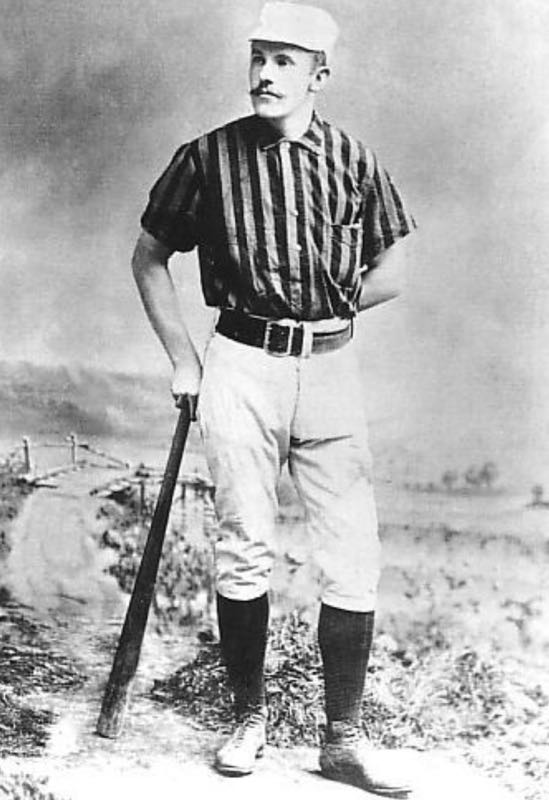 Is it just me, or do others also find that most Easter Bunnies appear seriously malevolent??  A Secret Agent, and Another Missing Manse Anna Keichline was born in Bellefonte in 1889 and by age 14 had won a local industrial-design competition. She graduated from Cornell with a degree in architecture and is considered to be “the first woman to actually practice architecture professionally” in the U.S. This stone house in Bellefonte is one of her many designs, along with other homes, schools, theatres, automobile dealerships, and other commercial buildings. By 1917, Anna owned and drove her own car and regularly did all the mechanical work on it herself. She also held a number of patents for efficiency-improving kitchen and interior designs and invented the “K-brick,” which preceded the concrete block. In 1913, she led the Bellefonte Suffragists’ march through the city.  Most intriguing of all, at the start of World War I Anna volunteered for service with the U.S. Army’s Military Intelligence Division in Washington, DC writing, “if you should deem it advisable to give me something more difficult or as I wish to say more dangerous, I should much prefer it.” She served as a Special Agent throughout the war.  This unusual building was the gatehouse and caretaker’s residence for the Union Cemetery in Bellefonte. Do you ever get the feeling that you’re being watched, even when no one is around? Only later did I spot the onlooker in this photo. (At least it wasn’t another dang Easter Bunny…)   Downtown Bellefonte, like the rest of the town, is unbelievably scenic.  Remember Governor Andrew Gregg Curtin, one of Roland’s four sons? Here he is, in front of the courthouse surveying the city where he lived. His home, just down High Street, is now an Elks Lodge. 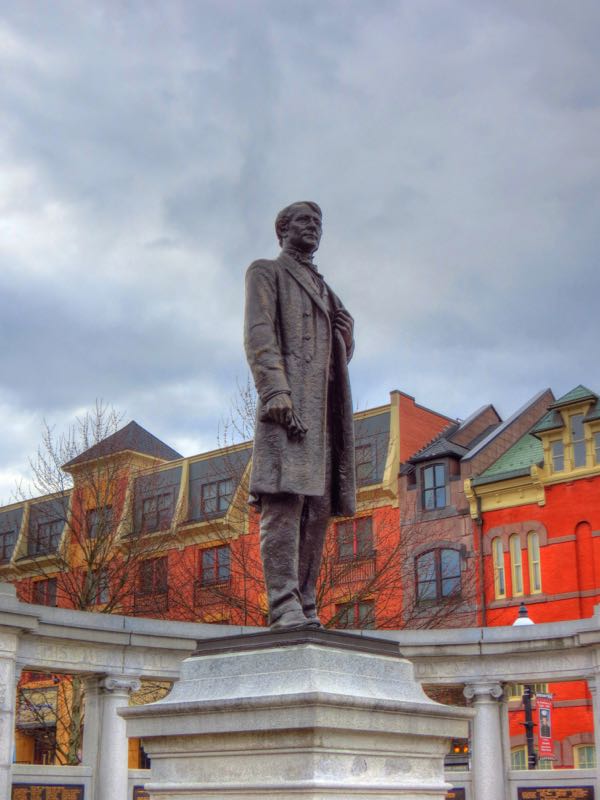 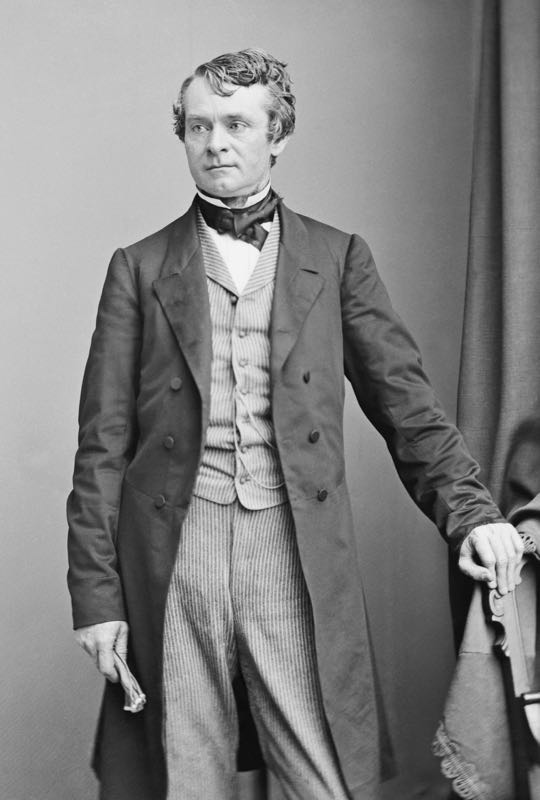 Also, remember the missing Presbyterian manse in nearby Milesburg? Well, the one in Bellefonte is missing, too. Confusingly, this ornate building is referred to as “The Manse,” but only because it was built on the site of the Rev. Dr. James Linn’s home. Built in 1881, it was the First National Bank and now houses law offices.  By now the day was getting on, but I just couldn’t pull myself away from Bellefonte. I had to visit the railroad station (now home to the Chamber of Commerce)… 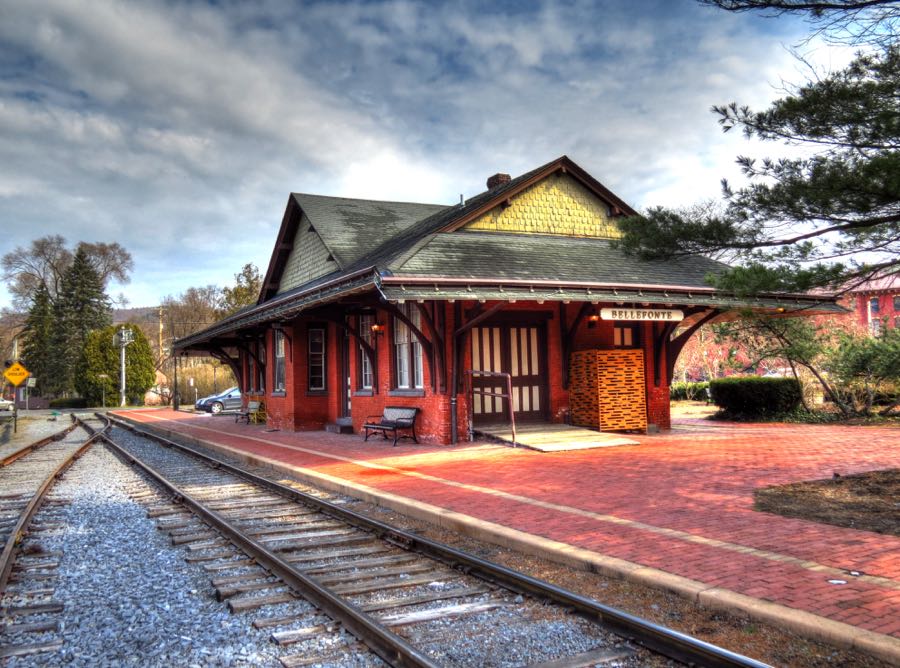 …and the Big Spring, which produces over 11 million gallons of water daily, enough to supply all of Bellefonte’s water needs and feed this sizable creek. Bellefonte, which means “beautiful fountain” in French, got its name from this spring—courtesy of Napolean’s chief diplomat Charles Maurice de Talleyrand Périgord. 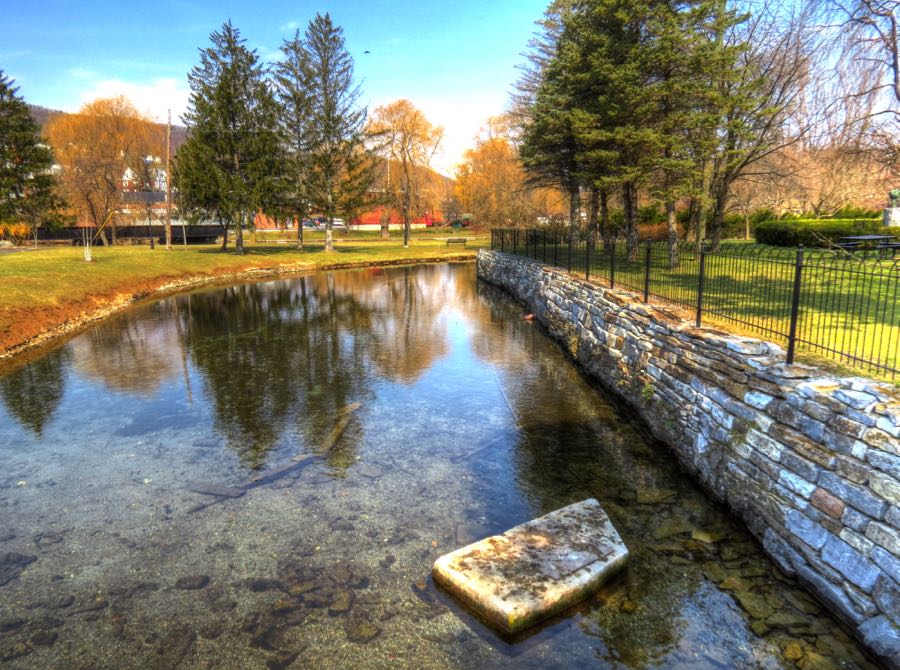 Plus, I had to check out this before-and-after look at Stoney Batter and Pine Streets. The stone cottage at the left is the same in both photos, but it’s hard to determine if the houses on the right are the same.   Walking down the steep hill to where I’d parked, I took a shortcut along the old rail line. The tracks continued into what was once the Pennsylvania Match Company. Among other tenants, the American Philately Society is now headquartered here. (As in stamp collecting, in case you weren’t sure. A classic old joke: Willis says to the woman of his dreams, “You’re more beautiful than any stamp in my collection.” She responds, “Philately will get you nowhere.”)  I finally departed Bellefonte with great reluctance; I’d fallen in love with this remarkable place and its history. But I had more sights to see, not to mention another 220 miles before reaching home. It’s times like this when it’s very helpful to have 300 horsepower available! ”Whimsical Victorian Eclecticism” Continuing on the RoadRunner route, I made the 25 miles to Millheim in short order. This “home of the mills” benefited from the fast-flowing Elk Creek, and it prospered as a way station for pioneers traveling west in the late 1700s. The Millheim School has been vacant for a long time and is still waiting for what the town planners call “successful adaptive reuse.” Because the school is set back from the road where I parked, its scale is a little hard to judge. For perspective, standing on my tippy-toes I still could not reach the camera up to the level of the first-floor windows for a picture inside.  Millheim is full of wonderful old houses in the “whimsical Victorian eclecticism” style, but the most wonderful and whimsical of all is the 1890 Gladys Rearick mansion. Gladys was born in 1914 and passed away in 1999, having lived here for many years. Yes, the house could use a little refurbishment, but it is still a marvelous jumble of gables, towers, ornate wooden trim, and a porch that wraps around seemingly forever. After years of standing vacant, the house is being renovated by its new owners—and I wish them great success.   After rushing along Routes 45 and 235, I stopped for a moment to admire Penn’s Creek. The water level looked normal, but there were neither Fall Colors nor Signs o’ Spring.  Rust in Peace On Highway 235 approaching McAlisterville, I stumbled across something that no self-respecting gearhead can ignore: a small, roadside automobile junkyard. It had an odd assortment of vehicles, ranging from VW buses to a major dump truck. In the foreground of this photo is a 1941 Cadillac hearse, with body by Eureka. It’s fairly complete but has terminal rust. Some sources indicate that only 41 of these behemoths were produced before Detroit production turned to tanks and aircraft for World War II.  As my friend Peter Egan’s wife, Barb, once remarked, “Too much patina!” As I peered through the hearse’s door, my heart skipped a beat: the dashboard clock read 2:55—which was exactly the right time. There was no way that this 76-year-old clock was still working, and I began to wonder “Could hearses be, like, haunted, dude?”  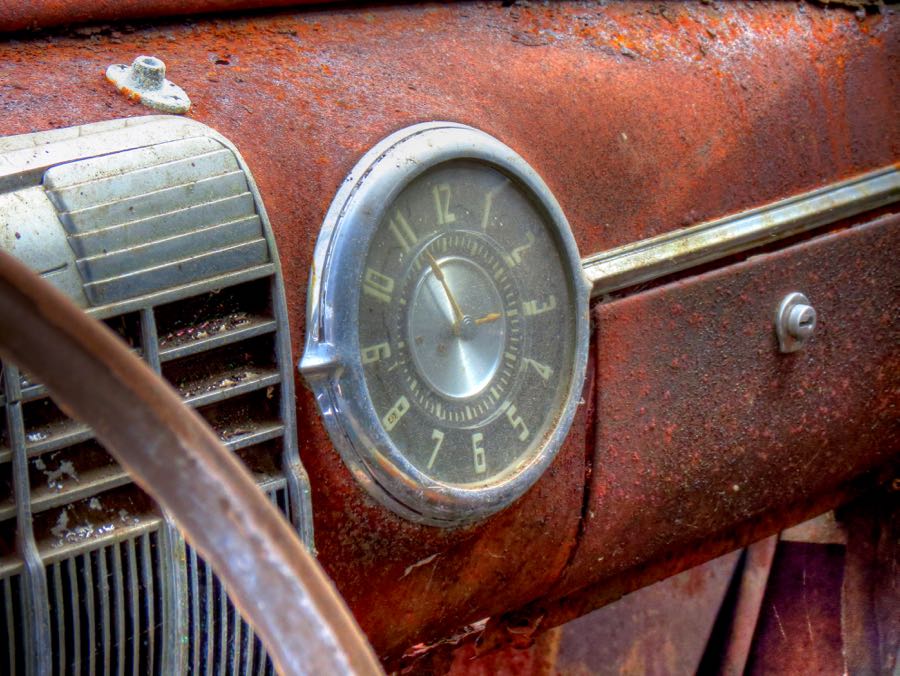 I know, I know. Even a stopped clock is accurate twice a day. I’ll chalk this up to coincidence if you insist, but I’m still wondering! Elsewhere in the lineup, I admired this 1959 Ford Galaxie 2-door hardtop. Usually the big block is under the hood…  There was almost nothing straight on this humble little Willys Jeep CJ from the early 1950s, but it was charming nonetheless. All these cars are just waiting for the right person to come along and rescue them. Been waiting a long time, I’d say.  By now I was three-fourths of the way back to the southern border of Pennsylvania, and my trip was nearing its end. I’ll leave you with a triptych of covered bridges, namely the Saville, Kochendefer, and Dimmsville.  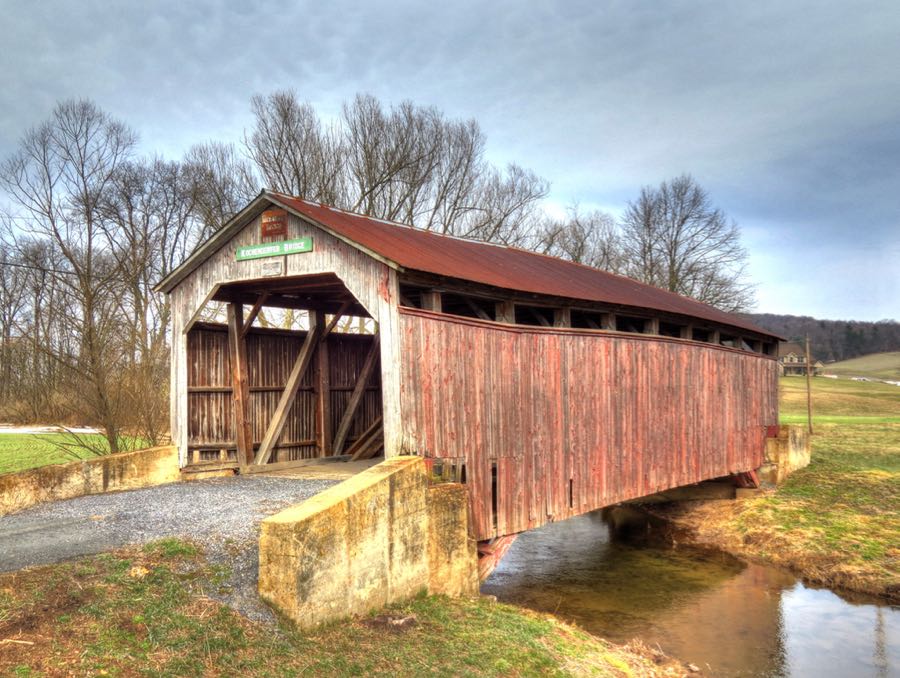  I’d seen the Dimmsville Bridge on an earlier trip, and I was curious to learn whether it was still standing. I bumped into a nice young couple who were doing a covered bridges tour, and I showed them where the old road had led up to the bridge. We found that it is now leaning at the even-more-precarious angle of nearly 40° from vertical. Less than 2 years earlier, the angle was “only” 25°. I don’t give it much longer, and it will be a real shame when it falls over into Cocolamus Creek.  Throughout my 3-day, 831-mile trip, the 335i ran flawlessly. It’s easy to forget during normal daily use that these E90-series cars were the epitome of what made BMWs famous as “the ultimate driving machine”: outstanding handling, acceleration, and braking, together with steering that lets you know exactly what the front tires are doing. Trips like these allow you to focus on serious driving, which instantly brings forth vivid reminders of these great qualities.  Not to mention that the car also kept me comfortable with its MSport seats and entertained with high-quality music, details about average speed, fuel consumption, car condition, tire pressures, and so forth, and the ability to lower the top and be part of the great outdoors. It was a wonderful tour, even without Fall Colors, and I can’t wait to embark on the next one. Rick F.  Map courtesy of GPS Visualizer. |
|
Appreciate
17
ake21.50 mjsaville102.00 //M235ixD97.50 Xtabi1755.00 Bosozoku696.50 DieGrüneHölle1308.50 1M Tex283.50 MSportTune280.50 Niko ZV119.00 MSCD3184.50 Jtjjen28.50 ando2258.50 Antetokounmpo1559.50 Torgus3795.50 BeastMode335i1171.50 listed582.50 bcoz82.00 |
| 04-22-2017, 06:27 PM | #2 |
|
Lieutenant
   
132
Rep 535
Posts |
You are better than National Geographics! Thank you very much for such wonderful stories and photos!
P.S. My only gripe is that you keep editing photos heavily and photoshoping them in terms of changing colors, lighting and hues...  Man how I wish you did not do that, but I can't insist, it's your choice of course. It's just nature and historic places are best looked as they are - without any photoshopping - it just ruins it man. Lots of otherwise beautiful natural colors of forests and roads and buildings are changed by you and imho look very unnatural like too much fantasy colors and vivid hues - I mean it's like we are looking at Disney cartoons man Man how I wish you did not do that, but I can't insist, it's your choice of course. It's just nature and historic places are best looked as they are - without any photoshopping - it just ruins it man. Lots of otherwise beautiful natural colors of forests and roads and buildings are changed by you and imho look very unnatural like too much fantasy colors and vivid hues - I mean it's like we are looking at Disney cartoons man  We already noted that and asked you to maybe consider portraying it as it is without any editing, but it seems you chose otherwise, well, what can we do, it's your choice i guess We already noted that and asked you to maybe consider portraying it as it is without any editing, but it seems you chose otherwise, well, what can we do, it's your choice i guess End of rant |
|
Appreciate
0
|
| 04-22-2017, 08:13 PM | #4 | |
|
Lieutenant
   
132
Rep 535
Posts |
Quote:
P.S. HDR was created only to overcome limit of dynamic range that low level cameras had. It is easily avoided if you have a descent camera setup - meaning proper sensor size and lens combo. However, OP is just killing it with oversaturated colors and post-processing. He is using Canon PowerShot SX40 HS - that's a $320 camera new or $100 used. If I was cruising in a hard-top convertible BMW to such a beatiful places - i would have invested in a better camera first (instead of those fancy rims  but what do I know eh? Again, not to rub, but best would be to keep pictures as they come from camera, maybe only playing with lighting, but keeping colors intact but what do I know eh? Again, not to rub, but best would be to keep pictures as they come from camera, maybe only playing with lighting, but keeping colors intactLast edited by n55jb4; 04-22-2017 at 08:20 PM.. |
|
|
Appreciate
0
|
| 04-23-2017, 05:16 PM | #6 |
|
Second Lieutenant
 
316
Rep 293
Posts
Drives: 2008 E93 M3
Join Date: Apr 2014
Location: Perry, GA
|
You are an artist! Thanks for sharing!!
|
|
Appreciate
0
|
| 04-23-2017, 05:49 PM | #7 | ||
|
Lieutenant Colonel
 963
Rep 1,910
Posts |
Quote:
Quote:
First, I'm glad you enjoyed the trip report. It was certainly a fun and interesting tour to do. I appreciated your earlier advice (in a different thread) about overdoing the photo processing. Believe it or not, based on your comments I actually scaled back significantly on the photos for this report—although clearly not to the extent that you would have preferred. Part of the issue involves personal preference. I like photos that "pop," while you dislike photos that pop to the point of exploding. Maybe I can blame my propensity for very bright colors on decades of using Kodachrome film in the pre-digital days. Here are a few examples of Kodachrome photos I pulled from the internet:   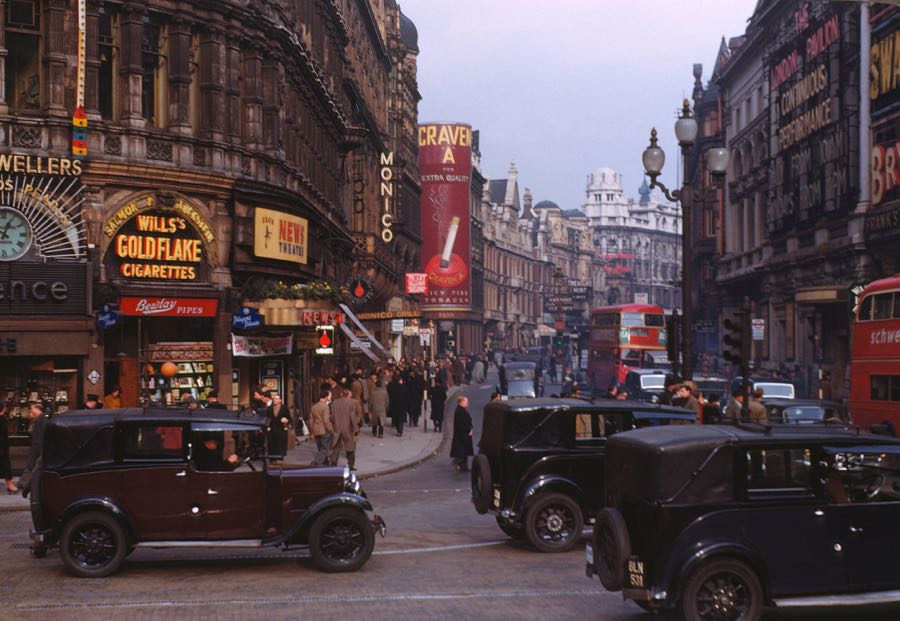  These are all pretty saturated, which was a characteristic of this film. I think they look great, but YMMV. Here's another, digital example from Road & Track magazine. It's a terrific photo, and it's clear that a lot went into it, but the colors are probably somewhat "larger than life."  I was particularly interested in your comments about cameras. I've used the Canon SX40 HS (and its predecessors) for a long time, in large part because it's very convenient to have a zoom range of 24-840 mm (equivalent) without changing lenses. The image stabilization, flexible view screen, and video quality are also big pluses, not to mention the convenient size and weight. On the other hand, I didn't realize that DSLRs would provide much better dynamic range. The better resolution and picture quality would also be nice, of course. Regarding post-processing, here's a shot of one of the covered bridges,right out of the SX40, with no processing. Note the "flat" appearance and the total lack of any color in the sky, which was, in fact, a nice light blue with thin clouds. I don't consider this image satisfactory.  Using Photomatix Pro's default setting for HDR, together with my other two exposures, produces the following result. The dynamic range is far better, and matches what you actually see much more closely. For my taste, however, it's still a bit flat.  Adjusting the levels in the above picture slightly, using Photos (Mac) software, produces this version, which shows a decent amount of contrast and dynamic range—pretty comparable, I think, to what the scene actually looked like. I'm reasonably happy with this result, but I'm interested in your thoughts.  Finally, here's the version that I actually used in the trip report, with more saturation, some gamma and white point adjustments, and Photomatix's medium "lighting effects." I'm not unhappy with the result—actually I pretty much like it—but I recognize that it's a step beyond what you see in person. My primary concern is that the front section of the bridge is somewhat washed out.  I'll be experimenting with some other settings in between the Default and Rick F. extremes. Where I end up may still be "too much" in your view, but I'll continue to be interested in your thoughts on the subject. All the best, Rick |
||
|
Appreciate
2
Jtjjen28.50 BeastMode335i1171.50 |
| 04-23-2017, 05:54 PM | #8 | |
|
Lieutenant Colonel
 963
Rep 1,910
Posts |
Quote:
Thanks much! I generally get about 10 to 15 favorable comments on the photos for every one objecting to overuse of HDR and saturation—but I'm hoping there's a happy medium out there somewhere that everyone will find pleasing. Most of the complaints I get are that the reports are too long. I agree, and it takes forever to prepare them, but I can't bear to leave out a good story. Also, I try to follow Mark Twain's advice to "Never let the truth get in the way a good story."  Thanks again, Rick |
|
|
Appreciate
0
|
| 04-23-2017, 05:56 PM | #9 | |
|
Lieutenant Colonel
 963
Rep 1,910
Posts |
Quote:
I'm glad you liked the report. See comments above regarding HDR et al. The basic problem started when I installed a JB4 in my photo processing software…  Rick |
|
|
Appreciate
0
|
| 04-23-2017, 05:59 PM | #10 |
|
Lieutenant Colonel
 963
Rep 1,910
Posts |
Wrecker335d,
My pleasure, I'm glad you enjoyed it. Here's a question for you: How much of the old Bridgehampton Racetrack is left on Long Island? It's interesting to visit such places, and I might like to work in a trip there sometime. Rick |
|
Appreciate
0
|
| 04-23-2017, 06:07 PM | #11 |
|
Lieutenant Colonel
 963
Rep 1,910
Posts |
Flyboy,
Aw shucks, I bet you say that to all the posters! Seriously, I appreciate it. While most of my photos involve a quick choice of vantage point and two sets of exposures, since I'm almost always behind schedule, once in a while they come out in a way that I'd consider artistic. I've always liked this photo of a Lotus Elite vintage racing car at Thompson Motor Speedway, for example. However, it has a massive amount of HDR and saturation. Just thought I should warn readers! Rick  |
|
Appreciate
0
|
| 04-23-2017, 06:51 PM | #12 |
|
Second Lieutenant
 
316
Rep 293
Posts
Drives: 2008 E93 M3
Join Date: Apr 2014
Location: Perry, GA
|
I worked with a photographer back in the early eighties and some of those most interesting images he produced required a certain amount of "push" in the darkroom. It was fun to watch the images change and really develop some pop. Nowadays the cameras are so much better and the software. But the eye is still the most import tool you have. And you sir, definitely have the eye!
I was just in another thread you posted about the Indian Wars, and interestingly enough, my original ancestor (orphan) fought alongside General Clark during that time. Eustace McDonough was his name. After being shot in the shoulder he retired to Randolph County Illinois and 236 years later, here I am. Beautiful photos and fantastic narrative. |
|
Appreciate
0
|
| 04-23-2017, 08:17 PM | #13 |
|
Captain
    
312
Rep 766
Posts |
Talk about future goals in this thread. I am loving the photos taken. What kind of camera are you using , they are coming out very detailed and eye capturing with whatever you are using, wether it be an iPhone or a professional 🎥 camera. Please keep these photos and stories of intrigue coming. Inspiring to say the least...
 |
|
Appreciate
0
|
| 04-25-2017, 03:20 PM | #14 | |
|
Lieutenant Colonel
 963
Rep 1,910
Posts |
Quote:
That's really interesting about your ancestor Eustace McDonough. The Foster family goes back quite a ways in this country, and I've got a good genealogy that was done back in the 1940s, but I don't know very much about most of the individuals listed. Something else to research one of these days! Rick |
|
|
Appreciate
0
|
| 04-25-2017, 03:27 PM | #15 | |
|
Lieutenant Colonel
 963
Rep 1,910
Posts |
Quote:
Thanks much! I've been using a Canon SX40 HS (and its predecessor) for a long time. It's a relatively small and light "superzoom" camera, with a range of 24mm (wide angle) to 840mm (long zoom) from its lens. The photo resolution is fairly good, but it doesn't have a really wide lens opening (so low light can be an issue). It has excellent image stabilization and movie capabilities. Overall, I've been very pleased with it, but I do entertain thoughts of a good DLSR from time to time. As for the reports, I'll definitely keep 'em coming! You can either advance-search this site for "Rick F."-initiated threads, or you can find the whole set of them here. Rick |
|
|
Appreciate
0
|
| 04-25-2017, 10:11 PM | #16 |
|
Save the manuals!
6066
Rep 6,760
Posts |
Huge fan of your threads! This is what driving is all about: just hit the road and adventure off into new areas. Love it!
__________________
'16 M3 | '23 718 Spyder  Past: E92 M3, F87 M2, E39 M5, etc |
|
Appreciate
0
|
| 04-25-2017, 11:18 PM | #17 |
|
New Member

2
Rep 28
Posts |
Love this, and all of your previous posts. Makes me miss my days in Germany where I would take weekend trips to.. Wherever the road took me until I was tired in a random direction. I enjoy living vicariously through your excellent stories and pictures. Thank you!
__________________
'12 E92 335/M-Sport/Nav/Prem/CA/Harmon-Kardon
|
|
Appreciate
0
|
| 04-26-2017, 06:30 PM | #18 | |
|
Lieutenant Colonel
 963
Rep 1,910
Posts |
Quote:
Great, I'm really glad you enjoyed the write-up! And I have to agree with you: one of the very best ways to enjoy a BMW is to use it to go places that are interesting and fun. I mean, track days are great, polishing and perfecting likewise, and modifications are quite enjoyable as well. But "grand touring" is a direct use of these cars' awesome abilities. Rick |
|
|
Appreciate
0
|
| 04-26-2017, 06:33 PM | #19 | |
|
Lieutenant Colonel
 963
Rep 1,910
Posts |
Quote:
I'm very pleased that you liked the report! As you say, there's something wonderful about driving off into the unknown and seeing what you discover, whether it's great roads, pretty scenes, interesting people, or whatever. Stay tuned, since I'm starting to plan my next outing! Rick |
|
|
Appreciate
0
|
| 05-14-2017, 03:58 PM | #21 |
|
Lieutenant
   22
Rep 481
Posts |
Awesome read and great photos! I appreciate it a lot that you shared your story with the community!
__________________
2015 ///M3 F80 [ Yas Marina Blue | Black Full Merino Leather | 19" Black-Light Alloy Wheels | M Double-Clutch Transmission | Carbon Fiber interior | Driver Assistance Plus / Lighting / Executive | Adaptive M Suspension | Harman Kardon Surround ] |
|
Appreciate
0
|
| 05-14-2017, 04:43 PM | #22 |
|
Almost completely sane

697
Rep 1,080
Posts |
Thanks for the fantastic post!
And yeah, I really miss Kodachrome 25 (and Panatomic-X).
__________________
'17 BMW M2 (BSM 6MT Exec CarPlay, TechnicPnP ASD bypass, IND M Perf shift knob + keyhole cover, Pedal Haus pedals + heel plate, 3M CR90 tint, BavSound Ghost woofers, Racing Dynamics strut tower brace, Dinan midpipe, Turner intercooler)
'00 Honda S2000 (Silverstone Metallic, black leather, factory titanium shift knob + front lip + trunk spoiler, front shock tower brace, front subframe x-brace) |
|
Appreciate
0
|
 |
| Bookmarks |
|
|